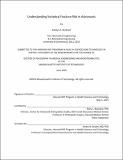Understanding vertebral fracture risk in astronauts
Author(s)
Burkhart, Katelyn A.
Download1119554541-MIT.pdf (2.590Mb)
Other Contributors
Harvard--MIT Program in Health Sciences and Technology.
Advisor
Mary L. Bouxsein.
Terms of use
Metadata
Show full item recordAbstract
In spaceflight, the loss of mechanical loading has detrimental effects on the musculoskeletal system. These muscular changes will likely affect spinal loading, a key aspect of vertebral fracture risk, but no prior studies have examined how spinal loading is affected by long duration spaceflight. Moreover, the effect of spaceflight on vertebral strength has not been determined, despite reports of significant vertebral trabecular bone loss in long-duration astronauts. Thus trunk muscle and vertebral bone changes and their impact on risk of injury following long-duration spaceflight remain unknown. This is of particular concern for NASA's planned Mars missions and return to Earth after prolonged deconditioning. Our lab has developed a musculoskeletal model of the thoracolumbar spine that has been validated for spinal loading, but has not yet been extended to maximal effort activities or full-body simulations. Thus, the overall goal of this work consisted of two main sections: 1) address the knowledge gap regarding spaceflight and post-flight recovery effects on trunk muscle properties, vertebral strength, compressive spine loading and vertebral fracture risk, and 2) extend our musculoskeletal modeling work into maximal effort simulations in an elderly population and create a full-body scaled model to investigate reproducibility of spine loading estimates using opto-electronic motion capture data. Whereas deficits in trunk muscle area returned to normal during on-Earth recovery, spaceflight-induced increases in intramuscular fat persisted in some muscles even years after landing. Similarly, spaceflight led to a decrease in lumbar vertebral strength that did not recover even after multiple years on Earth. To gain insight into the effect of spaceflight on vertebral fracture risk, we created subject-specific musculoskeletal models using an individual's height, weight, sex, muscle measurements, and spine curvature. We found that compressive spine loading was minimally affected by spaceflight and that vertebral fracture risk, calculated as a ratio of vertebral load to strength, was slightly elevated post-flight and remained elevated during readaptation on Earth. Additionally, we focused on the development of additional musculoskeletal modeling tools. Using maximal effort model simulations, we estimated trunk maximum muscle stress in an elderly population, and this critical parameter in musculoskeletal modeling will assist with more detailed model creation. Lastly, we found excellent reliability of spine loading estimations from opto-electronic marker data.
Description
This electronic version was submitted by the student author. The certified thesis is available in the Institute Archives and Special Collections. Thesis: Ph. D. in Medical Engineering and Bioastronautics, Harvard-MIT Program in Health Sciences and Technology, 2019 Cataloged from student-submitted PDF version of thesis. Includes bibliographical references.
Date issued
2019Department
Harvard--MIT Program in Health Sciences and Technology; Harvard University--MIT Division of Health Sciences and TechnologyPublisher
Massachusetts Institute of Technology
Keywords
Harvard--MIT Program in Health Sciences and Technology.